2020 Corvette – The Ultimate Guide
Introduction
The arrival of Chevrolet’s eighth-generation, mid-engine Corvette happened during an unprecedented time in modern history – it coincided (most unfortunately) with the arrival of the COVID-19 Coronavirus pandemic. The pandemic, which impacted the entire planet in a matter of just a few, short months, caused the world’s economies to come to a grinding halt, including production of the 2020 Mid-Engine Corvette Stingray.
Production of the mid-engine Corvette had already been delayed until February 2020 when the United Auto Worker (UAW) decided to strike in the fourth quarter of 2019. Because of the strike, the Corvette Assembly Plant in Bowling Green had been delayed in completing the necessary re-tooling to produce the mid-engine Corvette. In turn, this prevented GM from fulfilling early orders for the mid-engine Corvette before the end of 2019.
Would-be owners, many of whom had pre-ordered their cars after putting down sizable deposits to do so, waited patiently for the strike to end and for GM workers to return to work.
On February 3, 2020, Chevrolet officially began production of the mid-engine Corvette in Bowling Green. Chevrolet marked the occasion via the use of social media and literally “tweeted” the announcement from the plant.
After months of delays, the automotive world breathed a collective “sigh of relief” at the announcement. Once more, enthusiasts and would-be owners alike began clamoring for their opportunity to see a production version of the new Corvette at their local Chevrolet dealership and out on the open road. Early buyers began receiving shipment dates letting them know when they should expect their Corvette to arrive at their local dealerships. It seemed as though a production model, mid-engine Corvette was finally about to become a reality after more than a half-century of waiting and wishful thinking. The iconic rebirth of America’s Favorite Sports Car was actually happening.


Just over a month later, the rebirth was cut short – at least for the first half of the 2020 model year. On Wednesday, March 18, 2020, General Motors made the following announcement:
“Due to an overwhelming demand for the 2020 Chevrolet Corvette Stingray, Chevrolet has decided to stop taking sold orders after March 18, 2020,” a GM spokesperson said. “Chevrolet dealers will begin taking orders for the 2021 Corvette in late May.”
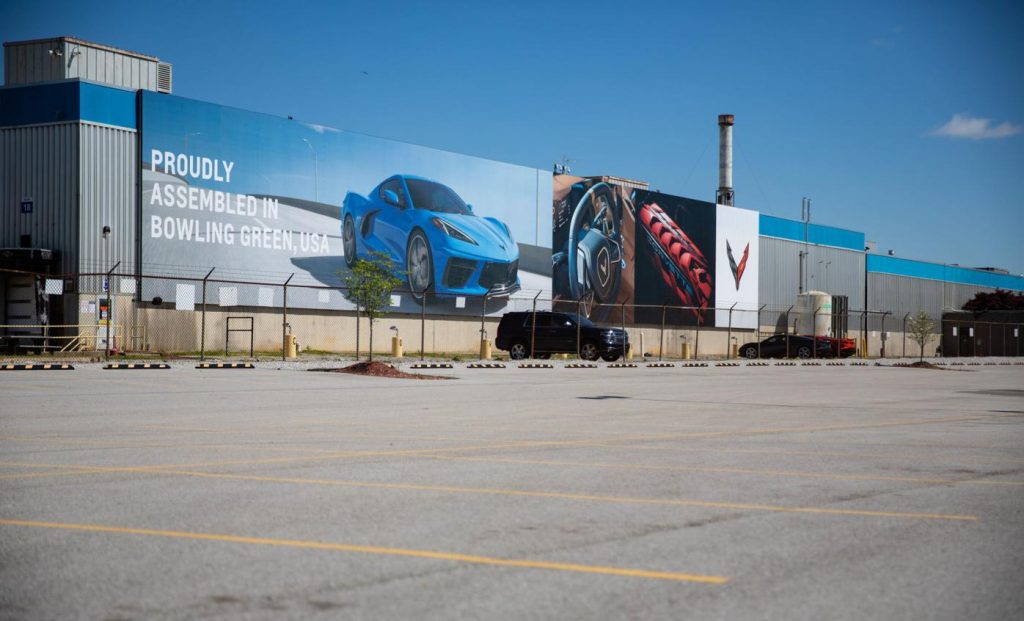
The announcement was made after Autoblog.com had discovered a post on Corvette Forum earlier that same day that showed a screenshot of an apparent email sent to Corvette dealerships, instructing them to suspend future 2020 Mid-Engine Corvette orders beginning later that day. The email cited the weeks-long UAW strike that had occurred in late 2019, and stated that “2021 Corvette orders would be available earlier than planned to enable dealers and customers (the opportunity) ‘to create a replacement order.”
Fortunately, earlier predictions that 2020 C8 Corvette production would not resume slowly began to subside as the second quarter of 2020 recognized a gradual decline in COVID cases and as U.S. President Donald Trump urged the nation to re-open the economy. Chevrolet, still cautious of the impact that a premature opening of the manufacturing plant could have on the health of its employees, waited and watched as new case numbers continued to decline.
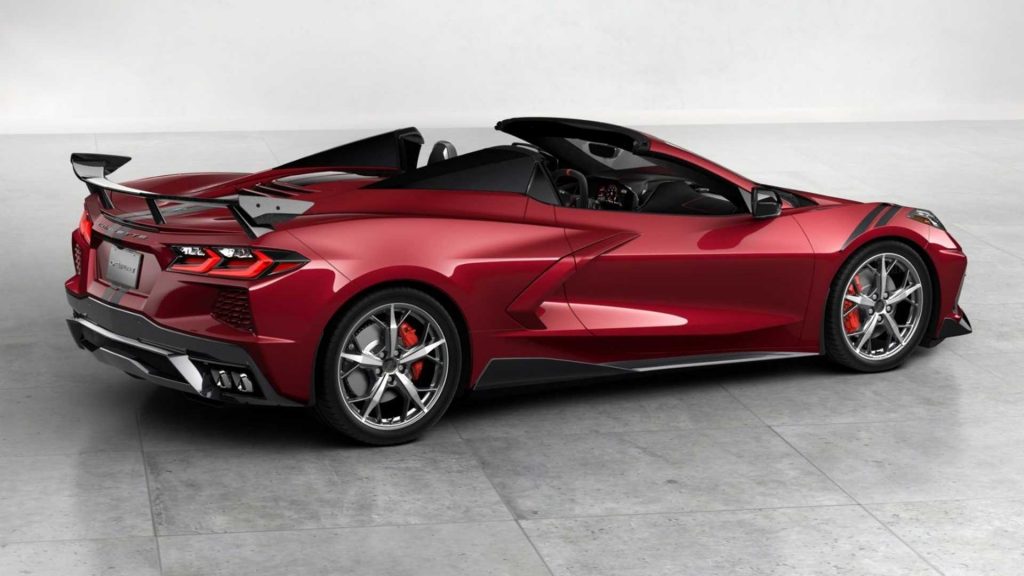
In June 2020, it was reported by Corvette Blogger that the newest iteration of the mid-engine Corvette – the C8 Stingray convertible – would begin production in August. On August 7th, Chevrolet delivered on its promise. Production of the Stingray convertible began in Bowling Green. Along with it came another announcement from General Motors that Chevrolet would not be skipping the 2020 model year as had been reported earlier in the year. Instead, production of the 2020 Corvette would resume in earnest. Further Chevrolet announced that production of the 2021 Corvette Stingray would not begin until November, 2020.
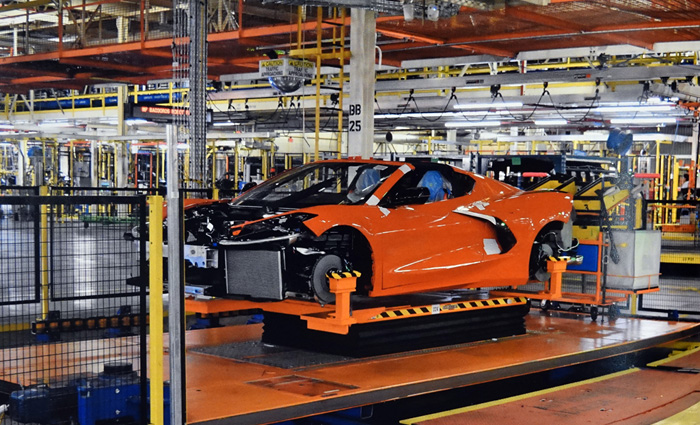
On September 1, 2020, Chevrolet increased production at their Bowling Green assembly plant, adding a second shift to the schedule. The increased production schedule started as little more than rumor propagated online and via social media that showed video of the plant’s employee parking lot full of vehicles at 11:30pm. Additionally, a private C8 Corvette Owners Facebook group began reporting that Chevrolet was running a second shift at the Bowling Green plant and also began publishing vehicle production numbers – including a report that stated “on September 1, 2020, (the Bowling Green Assembly Plant) built 140 Corvettes. The day before, the factory had produced 99 cars.”
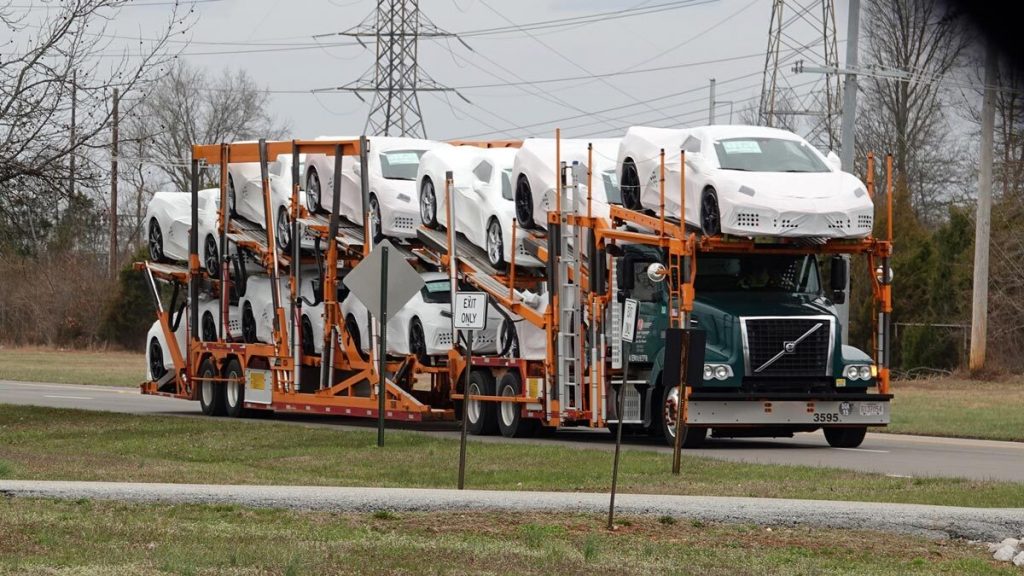
This latest news encouraged and delighted many would-be-and-waiting C8 Corvette owners. Of course, even with a second shift, Chevrolet will not be able to fulfill all of the orders that were initially placed for a mid-engine Corvette. However, as of September 3, 2020, Chevrolet was targeting a total production run of just over 20,000 units of the 2020 Corvette. On top of that, there have been several reports that UAW workers at the plant have already begun pre-production of the 2021 Corvette models. Assuming all this is true, the Corvette plant in Bowling Green will be incredibly busy throughout the remainder of 2020 and well into 2021.
The 2020 Mid-Engine Corvette Stingray
Even with such a controversial and ever-changing narrative behind its inaugural year of production, there is little doubt in anyone’s mind that the 2020 Mid-Engine C8 is one of the best Corvettes ever produced by Chevrolet. In fact, there has been more demand for the C8 than any Corvette built in the last twenty-five years. The car has attracted the respect and admiration of people of all age demographics, but most especially with Millenials and Zoomers – something that earlier iterations of the car have never been able to do.
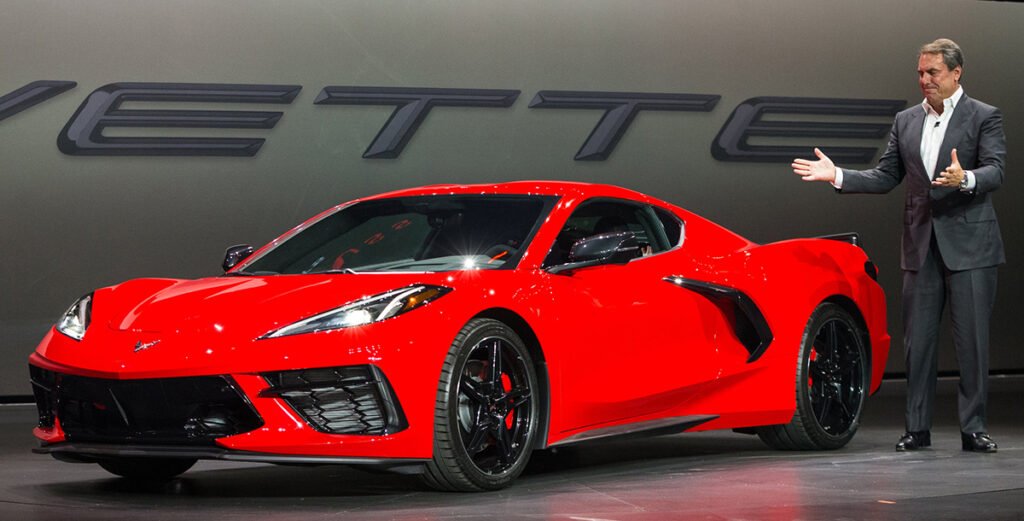
“Corvette has always represented the pinnacle of innovation and boundary-pushing at GM. The traditional front-engine vehicle reached its limits of performance, necessitating the new layout,” said GM President Mark Reuss. “In terms of comfort and fun, it still looks and feels like a Corvette, but drives better than any vehicle in Corvette history. Customers are going to be thrilled with our focus on details and performance across the board.”
While most people would agree that the new 2020 Mid-Engine Corvette is aesthetically stunning to look at, its design follows the decades-old mantra of “form follows function” that GM engineers have lived by as they developed each earlier iteration of America’s Favorite Sports Car. When looking at a C8 Corvette, there are features that immediately stand out to any observer – the shortened front hood, the massive air ducts just behind the driver and passenger doors, the unique-yet-somehow-familiar wedge-shape design, and of course, the familiar – yet reimagined – crossed flag badging that proudly identifies every Corvette that has ever been produced.
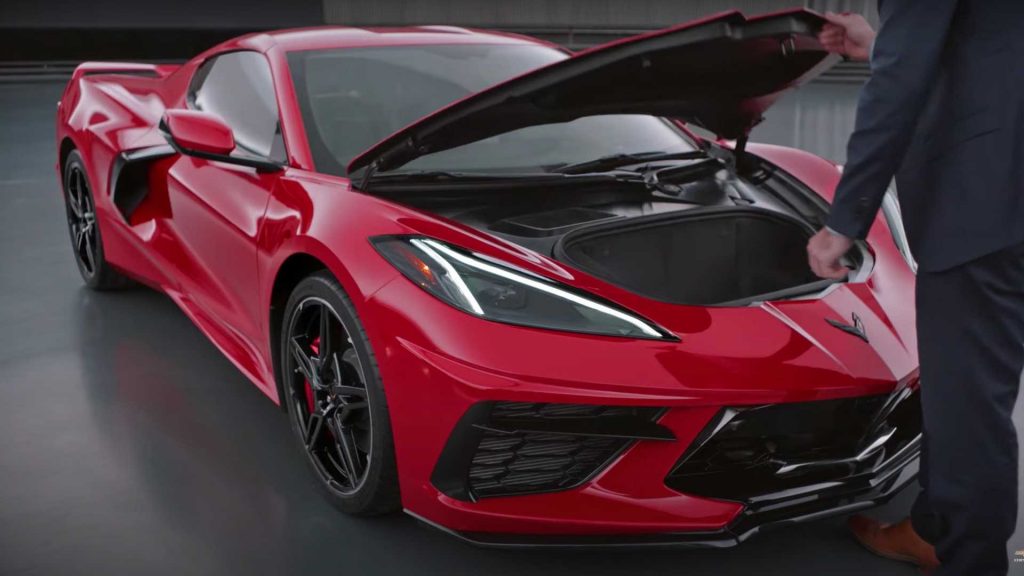
“As America’s most iconic performance nameplate, redesigning the Corvette Stingray from the ground up presented the team a historic opportunity, something Chevrolet designers have desired for over 60 years,” said Michael Simcoe, vice president of Global Design, General Motors. “It is now the best of America, a new arrival in the mid-engine sports car class. We know Corvette can stand tall with the best the world has to offer.”
But what, exactly, is the benefit of building a mid-engine variant of the Corvette? Afterall, Corvette did just fine, both on the track and the open road, with its traditional front-engine/rear-wheel-drive configuration for more than a half-century. The answers, once you see them, are pretty obvious.
The new mid-engine layout gives the 2020 Stingray:
- Better weight distribution, with the rear weight bias enhancing performance in a straight line and on the track.
- Better responsiveness and sense of control due to driver positioning closer to the front axle, sitting almost on top of the front wheels.
- The fastest 0-60 time of any entry Corvette ever — under three seconds when equipped with the Z51 Performance Package.
- A racecar-like view of the road due to the lower positioning of the hood, instrument panel, and steering wheel. Excellent forward sightlines throughout the vehicle for both the driver and passenger.
- An enhancement of Corvette’s traditional utility strengths, with dual trunks for a total of 12.6 cubic feet of cargo volume, ideal for transporting luggage or two sets of golf clubs. (per GM marketing).
Exterior
The exterior of the 2020 Mid-Engine Stingray took everything good from the sixth– and seventh-generation Corvettes and incorporated those elements into an entirely new design that is both bold and futuristic-looking in its design. The new 2020 Corvette was sleek, refined, lean-yet-muscular, with an overall aesthetic that communicates speed and performance at every angle. In addition to its appearance, the C8 Corvette featured a supercar level of craftsmanship, utilizing more premium materials than any other Corvette that came before it. The car featured a number of uniquely realized touchpoints that exude the grandeur of the car’s design along with the strong focus on detail that put into the placement of every component on the car.
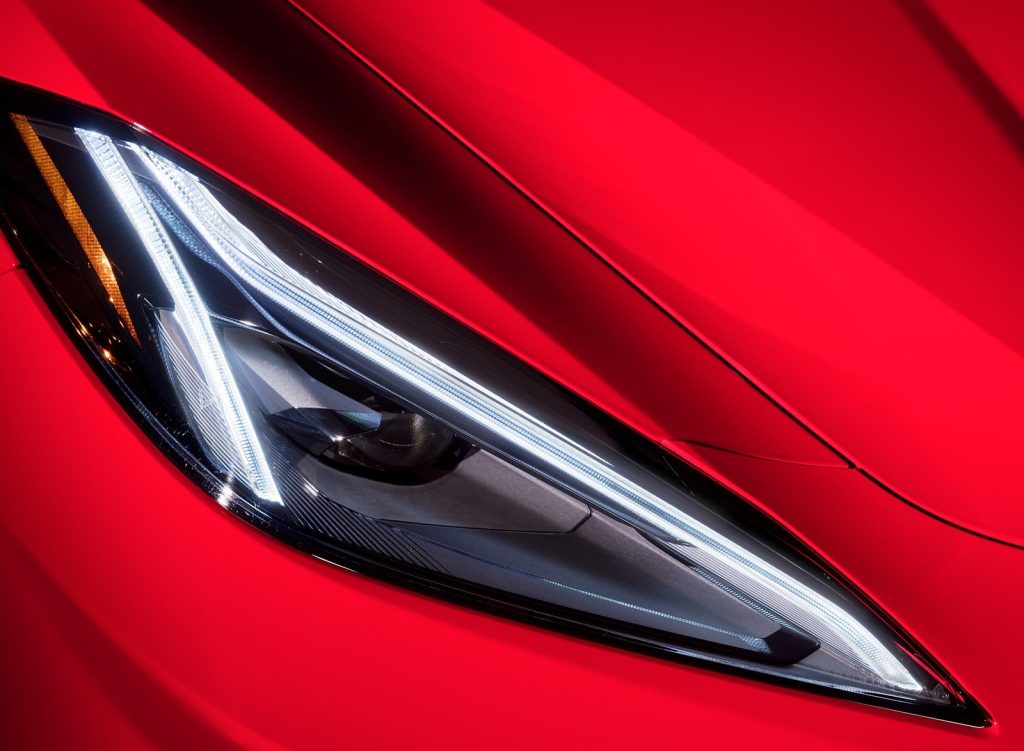
The exterior of the 2020 Mid-Engine Corvette featured design cues that were unlike anything that had come before it. These included:
- Low profile headlamps designed around all-new projectors.
- Completely hidden door, hood, and hatch releases do not disrupt the sculpted design.
- Large side air intakes for engine cooling and aerodynamic performance.
- A-pillar shape that communicates speed and assists in providing the driver with greater visibility.
- A large, rear hatch that showcases the engine with seven air vents.
- Quad exhaust tips located on the vehicle’s outboard end.
- Dual-element LED taillamps with animated turn signals.
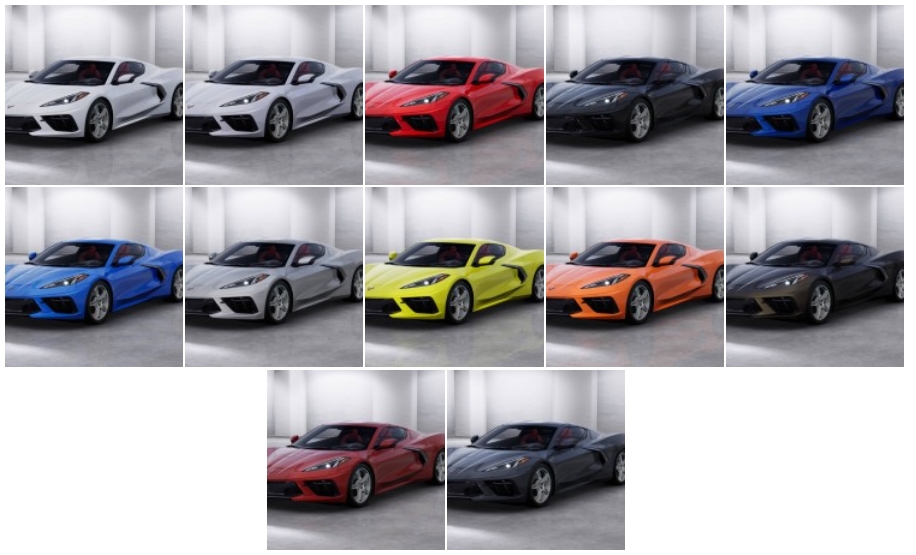
The 2020 Mid-Engine Corvette Stingray could be ordered in one of twelve exterior color choices, which included: Torch Red, Arctic White, Black, Blade Silver Metallic, Shadow Gray, Ceramic Matrix Gray, Long Beach Red, Elkhart Lake Blue and Sebring Orange — plus three all-new colors: Rapid Blue, Zeus Bronze and Accelerate Yellow.
Interior
When being developed by the team of Tadge Juechter, Tom Peters, and an entire team of specialized engineers and designers, many of the design elements incorporated into the mid-engine Corvette were inspired by some of the most advanced fighter jets in today’s armed forces. Additionally, the design team also turned to earlier iterations of the Corvette for signature elements that would give the Stingray a distinctive look that celebrated the history of the brand while also giving the car a bold new stance. While the exterior of the car was an evolution of the Corvettes that came before it, the interior of the new 2020 Stingray was completely reimagined.
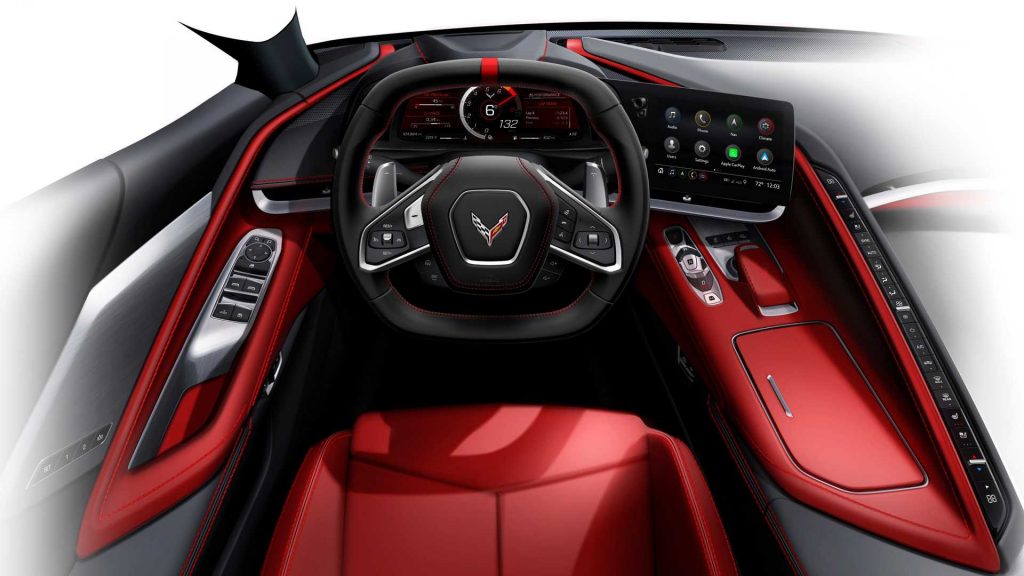
The 2020 Corvette Stingray’s cockpit is a significant departure from the C7. First, the cockpit was migrated forward by 16.5 inches, due in large part to the relocation of the engine to behind the driver. The cockpit was carefully crafted to envelop the driver. Much like the cockpit of the seventh-generation Corvettes, the C8 has more of a wrap-around cockpit that puts everything comfortably in-reach of the driver. A lot of attention was paid to the placement of the controls within the cockpit of the car to maximize driver visibility. Everything, from the vertically-mounted climate controls and transmission selector buttons to the ultra-thin temperature vents were selected to minimize the height of the instrument panel, providing the car’s occupants with a spacious interior.
All of the materials selected for the interior of the 2020 Corvette Stingray boast a high level of quality and craftsmanship. The car features a new, squared-off, small-diameter steering wheel that enables an unobstructed view of the 12-inch instrument cluster display. Like the C7, the C8 features a mostly digital dashboard that can be adjusted for various driving conditions based on driver selection. The steering wheel itself is hand-wrapped in leather with thick-press stitching. Unlike earlier iteration of the Corvette, which featured mostly plastic trim, the 2020 C8 Corvette features a lot of real-metal trim pieces within the cockpit, including stainless steel speaker grilles mounted over the Bose Performance Series audio system. Like the other materials selected for the cockpit, these metal components – either real aluminum or carbon fiber – add to the quality and overall aesthetic of the cockpit.
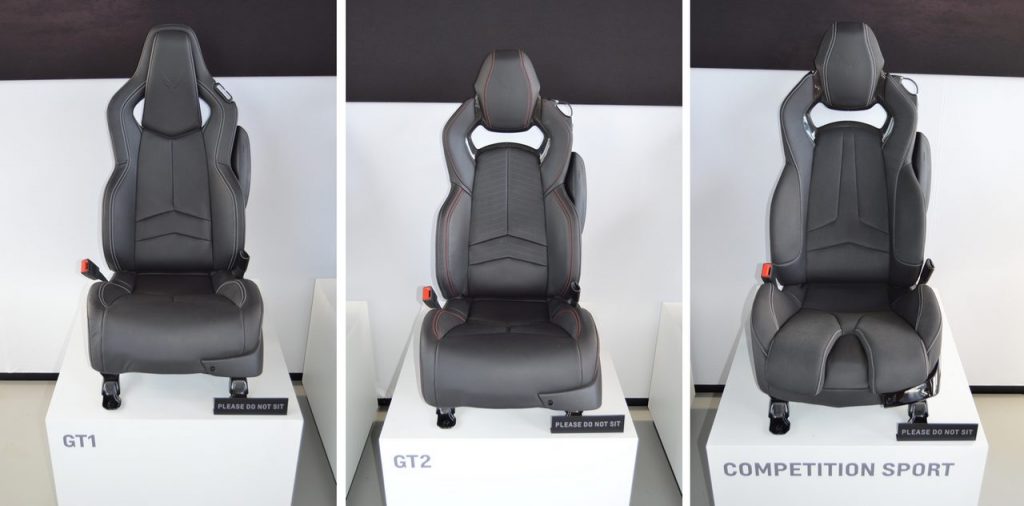
The seats, along with the rest of the interior, come finished in one of six interior color themes. These include:
- Jet Black
- Sky Cool Gray
- Adrenaline Red
- Natural/Natural Dipped
- Two-Tone Blue
- Morello Red
The interior features carbon-fiber trim on both the GT2 and Competition seats. As for the seats themselves, the 2020 Corvette was offered with three different seat options at the time of purchase. These included:
- GT1 Seats – a sporty seat that emphasized comfort while also providing good support to the driver during performance driving conditions. The GT1 seats came finished in Mulan leather trim and included optional lumbar support and side-wing adjustments.
- GT2 Seats – New for the 2020 Corvette, the GT2 seats featured a racing-inspired look with comfort for long trips courtesy of dual-density foam. As mentioned above, these seats included carbon-fiber trim, a Napa leather insert, Mulan leather bolsters, a jet black-painted seat back, two-way lumbar support and wing adjustment, plus heating and ventilation.
- Competition Seats – These seats were designed for the serious track-focused driver. They featured aggressive side bolsters, full Napa seating surfaces and carbon-fiber trim on the headrest. Each of these seats also featured built-in heating and cooling, along with an all-new durable performance textile material similar to the materials found in kevlar vests.
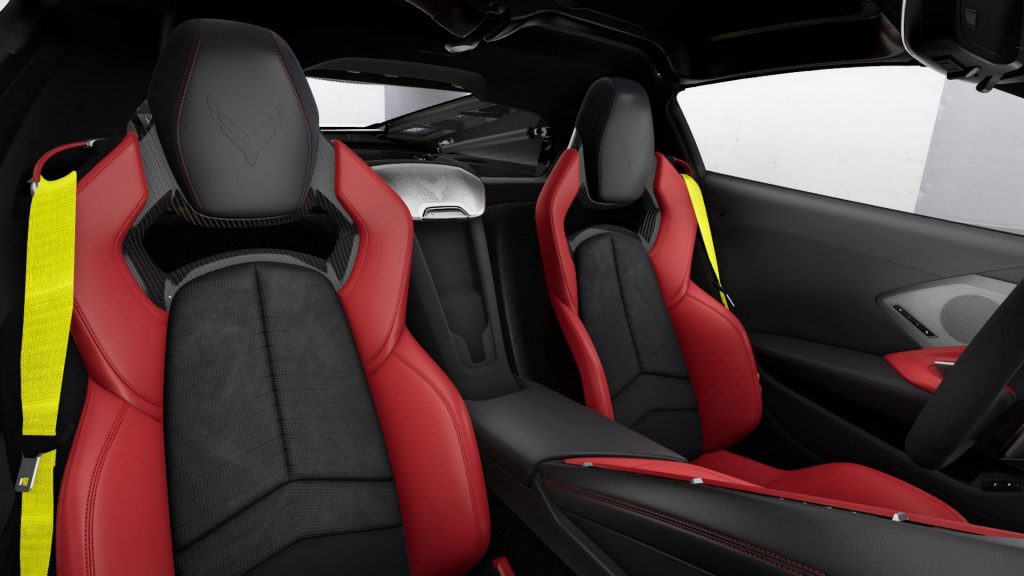
Regardless of seat and interior color selection, every 2020 Corvette also included six seatbelt color choices. Unlike earlier iterations of the Corvette, which matched seatbelt selection to the color of the seats, the 2020 Corvette allowed owners to select seatbelt colors based on personal preference. Would-be owners could select from black, blue, natural, torch red, yellow and orange seat belt colors, and pair them to any seat type and color the chose. For consumers looking to add even more customization to the interior of their C8 Corvettes, the 2020 model also offered consumers two optional stitch packages. These alternate stitch colors – yellow and red – could be selected and used for final assembly of stitching on the seats, dashboard and interior trim pieces.
Beneath the Hood – the “Jewel In the Center”
While the evolution of the C8 is an appreciable departure from other Corvettes, there is at least one element of the C8 that represents the earlier iterations of the Corvettes that came before it – the engine.
The 2020 Stingray features Chevrolet’s next-generation 6.2-liter, small-block, 6.2-liter, naturally-aspirated LT2 V8 engine. The LT2 engine produces 495 horsepower (369 kW) and 470-lb-ft (637 Nm) of torque when equipped with the C8 Stingray’s optional performance exhaust. So equipped, the C8 base coupe and convertible produced more horsepower and torque than any other entry-level Corvette in the brand’s 67-year history.
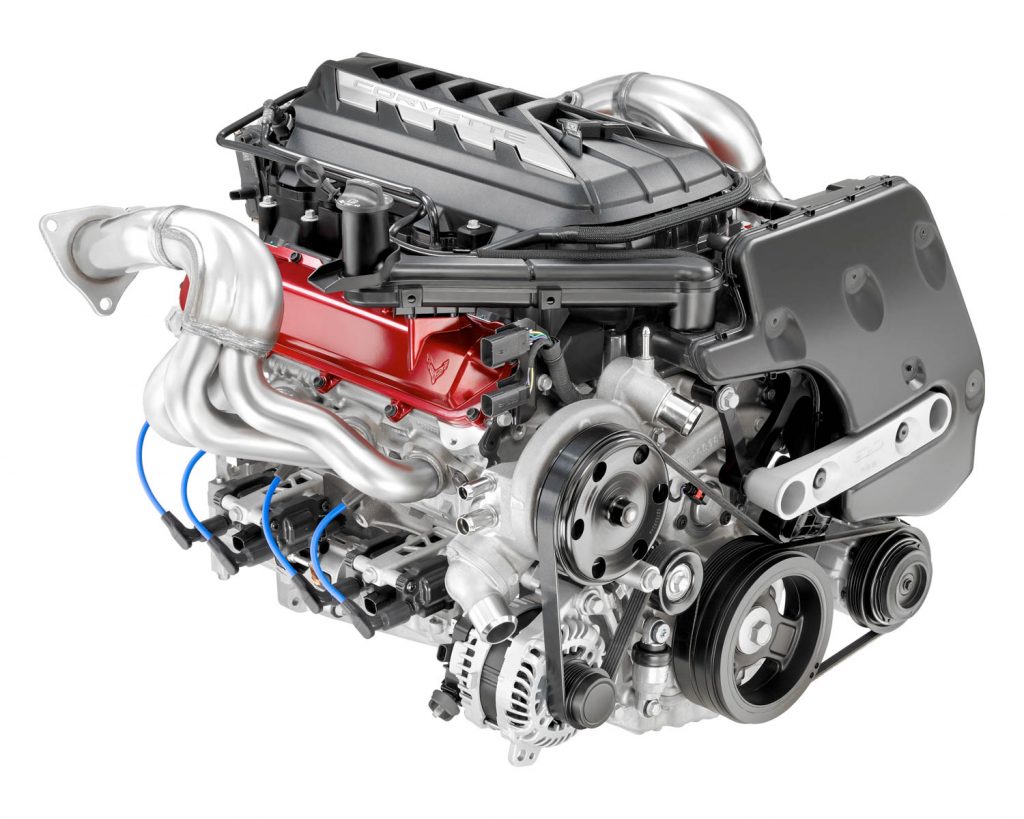
“Though now placed behind the driver, the LT2 gives the same visceral experience we all expect from Corvette,” said Jordan Lee, GM’s global chief engineer of Small Block engines. “The LT2 has been designed to deliver excellent low-end torque and high-end power to give thrilling pedal response at any RPM.”
When selecting the powertrain for the 2020 Corvette, it was vital that the placement of the engine (and transmission) were as low in the car’s chassis as possible. This was done to ensure an overall lower center of gravity for optimal handling. To enable engine fitment behind the driver and ahead of the rear axle, Corvette engineers had to be clever in the placement of the engine’s lubrication system. For the first time ever, the base Stingray featured an engine-mounted dry-sump oil system with three scavenge pumps for improved track performance. Previously, this type of lubrication system could only be found on higher-end iterations of the Corvette – such as the Z06 and the ZR1 models. Recognizing the C8 Corvette Stingray for what it was, the engineers behind the new Corvette’s engine program recognized that oil volumes needed to remain high during serious track driving conditions, and so the LT2’s dry-sump lubrication system had to be redesigned to provide exceptional engine performance even at lateral acceleration levels exceeding 1G in all directions.
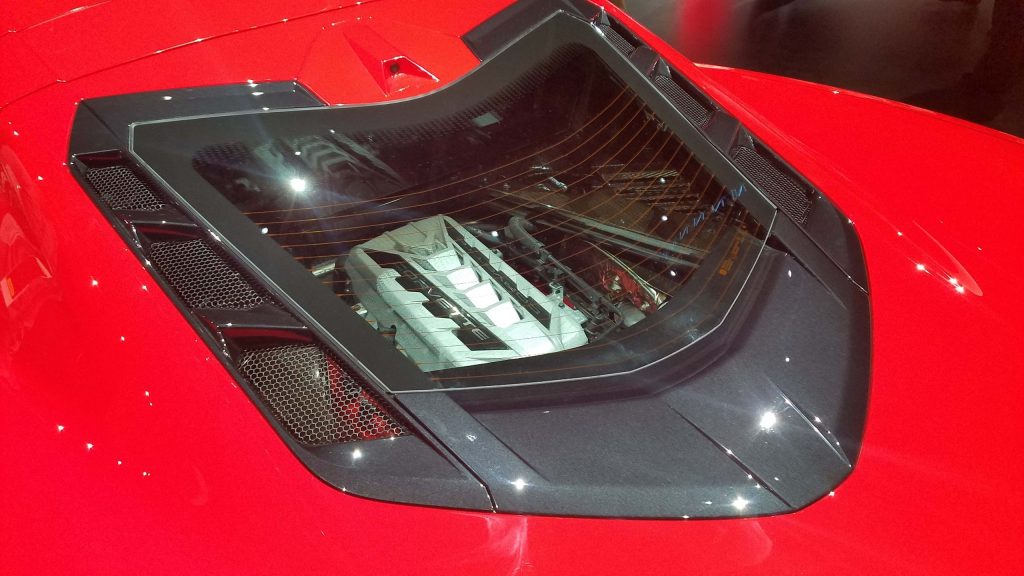
With the engine placement towards the rear of the car, Corvette engineers also recognized the importance of showcasing the engine as the center “jewel” of the new Stingray. Much like Ferrari, Lamborghini and MacLaren (to name just a few), the new Stingray now featured a lightweight, 3.2mm-thick glass panel on the rear hatch of the car that allowed owners to showcase the car’s engine. This panel featured a cantilevered trailing edge that was designed to evacuate heat for the LT2′ engine compartment. Every component, including the exhaust system’s wiring, tubes, routine fasteners, coolant hoses, exhaust manifold – even the bolts and fasteners used throughout – were selected and installed with the appearance in mind. Every engine component was given careful consideration just like the car’s exterior. Even the engine heat shields were specially textured.
Only an Automatic?
For the first time in Corvette’s history, the 2020 model did not feature a manual transmission. The decision to eliminate the option from the mid-engine Corvette was fairly straight forward – quicker, more reliable shifting during any type of driving condition combined with a more premium feel for would-be owners.
The 2020 C8 Corvette’s LT2 engine was paired to Chevrolet’s first-ever eight-speed, M1L dual-clutch automatic transmission, which provided customers with lightning-fast shifts and excellent power transfer from the engine to the rear wheels. The transmission was specifically designed for the C8 Corvette in cooperation with TREMEC with the intent of providing C8 owners with the convenience and luxury of an automatic transmission that still offered those drivers that wanted it a more spirited, directly-connected feeling of a manual transmission.
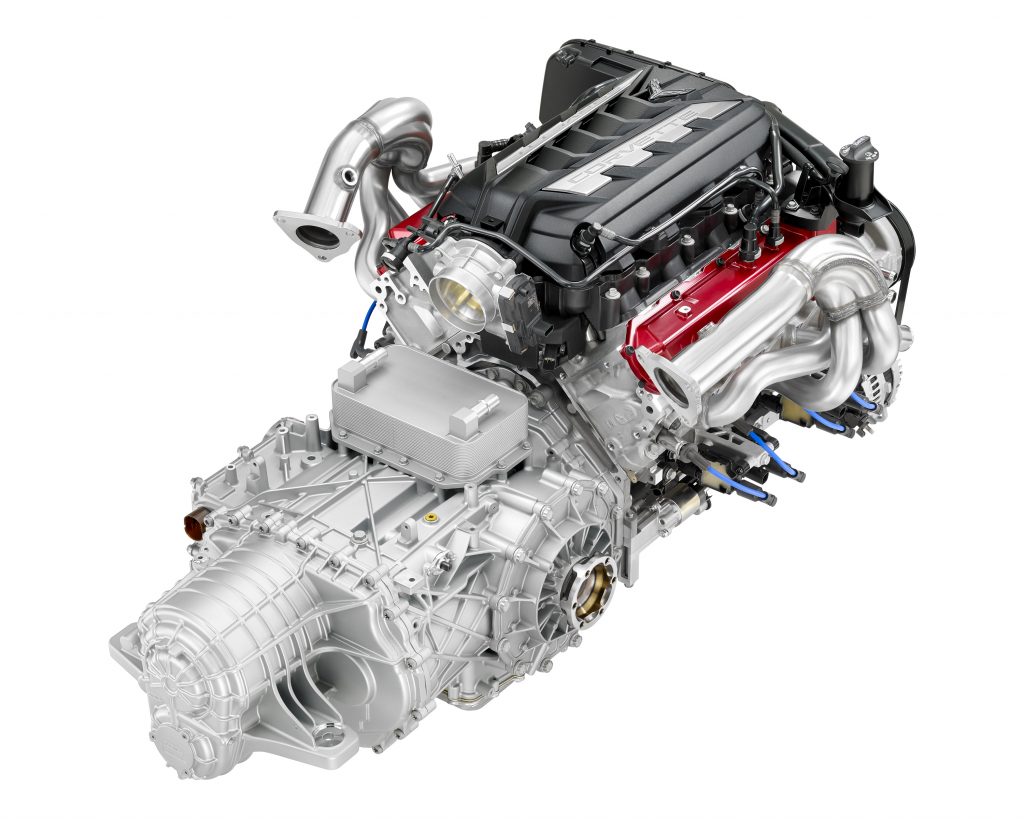
The 8-speed automatic transmission still allowed drivers to have appreciable control over their vehicles. Paddle shifters mounted on either side of the steering wheel allowed owners the option to control shift points and select specific gears during vehicle operation. Additionally, the new Stingray offered consumers a “double-paddle de-clutch” featured that allowed drivers to disengage the clutch by holding both paddles down at the same time.
“The performance shift algorithms are so driver-focused, they can sense when you’re doing spirited driving — regardless of driving mode — and will hold lower gears longer for more throttle response,” said Juechter.
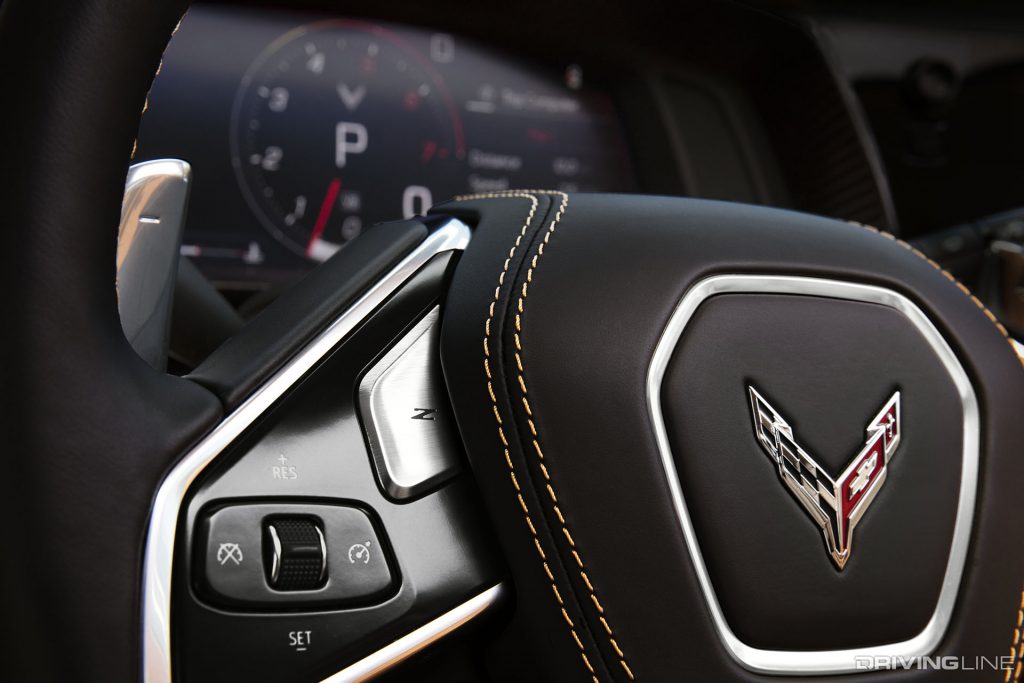
Corvette engineers set up the dual-clutch transmission (DCT) with a very low first gear ratio to leverage the additional traction needed to get the car off the line quickly, which its close-ratio (gears 2-6) keep the engine near the peak of its powerband while operating wide open on the track. The tall seventh and eighth gears were added for low RPM, long-distance cruising. These additional gears produced low mechanical stress on the engine and resulted in excellent fuel economy, despite the large displacement, high-horsepower engine at the heart of this car. The DCT was mated to a new Electronic Transmission Range Selector. With this electric shifter installed, there exists no mechanical interface between the shift lever and the transmission. The C8 Corvette’s electric shifter incorporated two pull toggles for Reverse and Drive and push buttons for Park, Neutral and Low/Manual. The shifter was designed to be more attractive and compact than a standard shifter.
When operating this Corvette, the driver has the option of selecting between one of six, unique driver modes, allowing the drivers to tweak the drivability of their Corvettes to their personal preference. As with earlier iterations of the Corvette, the same, familiar Weather, Tour, Sport, and Track modes returned in the 2020 Corvette, while two new modes were introduced:
- MyMode – This drive mode featured a configurable setting for a preferred driving style that can remain between key cycles.
- Z Mode – This drive mode was named after the famed Z06, ZR1 and Z51 Corvette performance packages. It is activated through a “Z” button on the steering wheel. This is a single-use mode that took MyMode configurations one step further, allowing drivers to adjust the operation and shift points of the engine and transmission as well.
C8 Corvette By the Numbers
As mentioned above, there were significant interruptions to the production of the 2020 Corvette. While Chevrolet made concessions to extend the production year late into 2020, it is hard to know exactly how many coupes and convertibles will be completed before the 2021 model year begins. That said, the final production numbers will not be able to be updated until the 2020 MY is complete. Based on GM’s promises to deliver as many 2020 Corvettes as possible, it is generally believed by consumers that as many as 22,000 Corvettes (estimated) will be produced for the 2020 model year. Of these, it is entirely possible that a greater number of convertibles will be produced, as manufacturing of the coupe was interrupted due to the COVID-19 pandemic.
In 2020, brand-new C8 Corvettes had a base MSRP price of $58,900 for the coupe and $66,400 for the convertible. Because of truncated production caused by the coronavirus, most (if not all) C8 Corvettes listed (at the time of this publication) had a listed sell price in excess of $100,000. As production numbers (and subsequently, availability) of the 2020 Corvette increase, it will be interesting to note how the asking prices for these cars change over time.
2020 Corvette Specifications
2020 Corvette Main Specs
| MODEL: | 2020 Chevrolet Corvette |
| BODY STYLE: | Two-door Coupe, Convertible with mid-engine, rear wheel drive configuration |
| MANUFACTURING LOCATION: | Bowling Green, Kentucky |
| VEHICLE NUMBERS (VIN): | TBD |
| CONSTRUCTION: | Composite body, hydroformed steel frame with aluminum & magnesium structural & chassis components. |
2020 Corvette Powertrain Specifications
| Engine | |
| Type: LT2 6.2L V8 VVT with direct injection and Active Fuel Management (cylinder deactivation) | |
| Valvetrain: Overhead valve, two valves per cylinder; dual-equal variable valve timing. | |
| Valves per cylinder: Two | |
| Number of Cylinders: Eight | |
| Displacement (cc/cid): 6,148cc / 375.4 cubic inches | |
| Fuel induction system: Direct injection with Active Fuel Management: Max pressure: 2,175 psi (15 Mpa / 150 bar) | |
| Horsepower (SAE net @ rpm): SAE-certified to 495 / 369 @ 6450 rpm (with performance exhaust) | |
| Torque (lbs.-ft. @ rpm) (DCT Automatic): SAE-certified to 470 / 637 @ 5150 rpm (with performance exhaust) | |
| Bore x stroke (in.): 4.062-inches x 3.622-inches | |
| Compression ratio: 11.5:1 | |
| Engine Materials | |
| Block: A319-T7 cast aluminum with cast-in iron cylinder liners and nodular main bearing caps | |
| Cylinder Heads: 319-T7 cast aluminum | |
| Fuel Economy | |
| Fuel Required: Premium | |
| Fuel Economy: 15 mpg city, 27 mpg highway | |
| Max cruising range: 499.5 miles (804 kilometers) | |


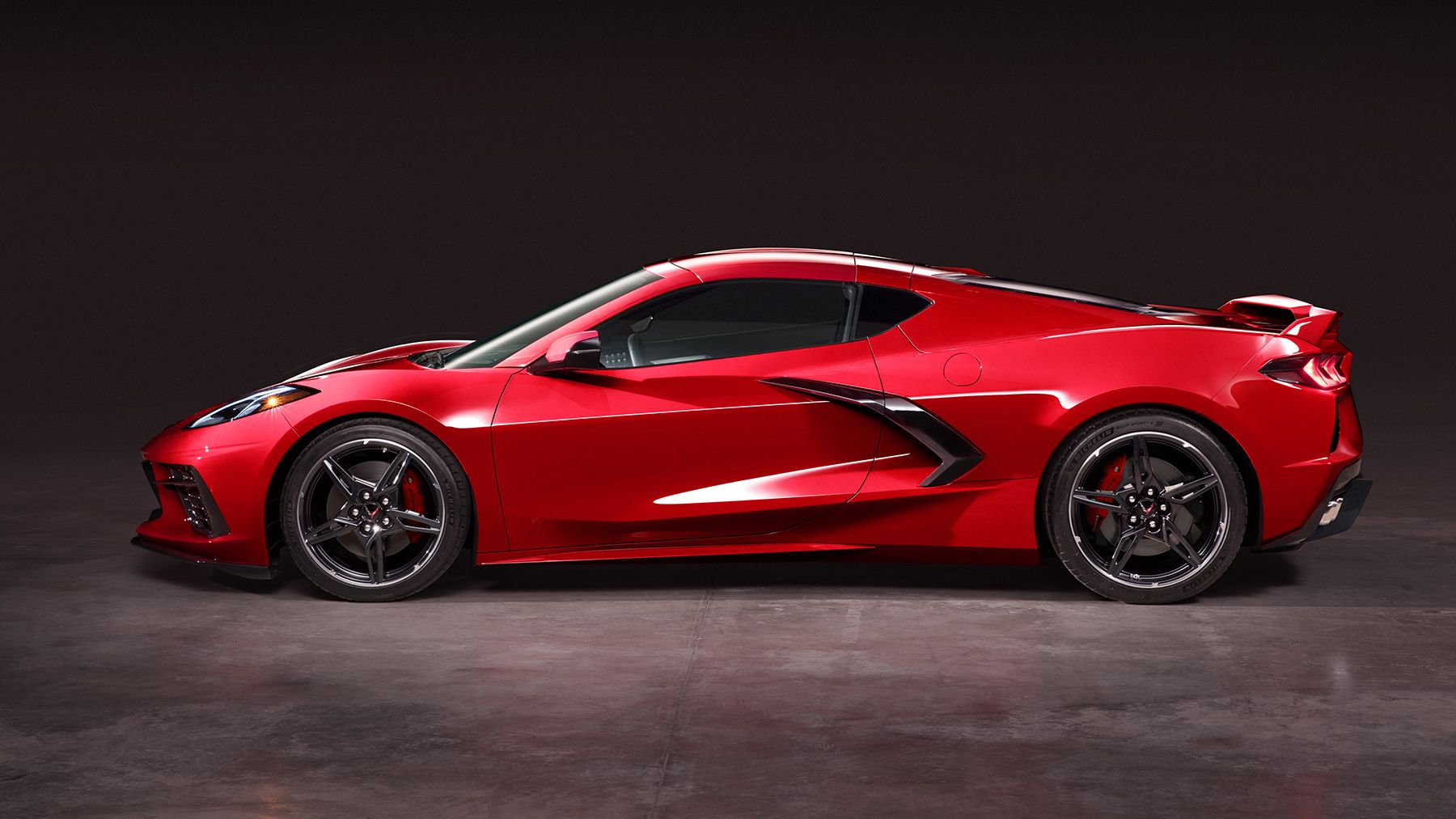

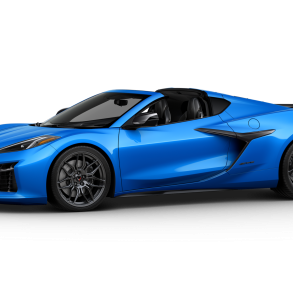
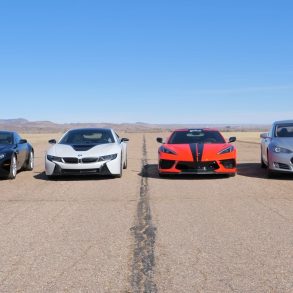
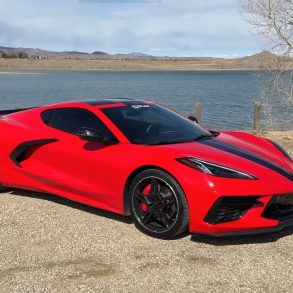
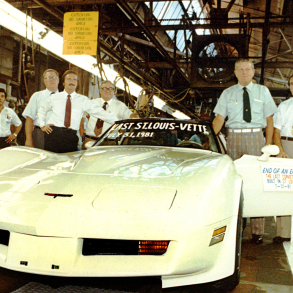
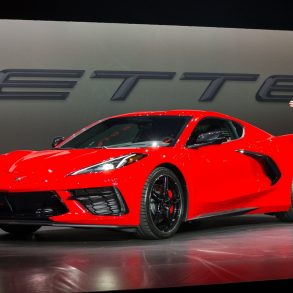
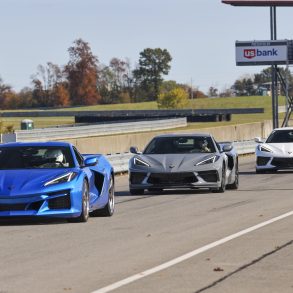
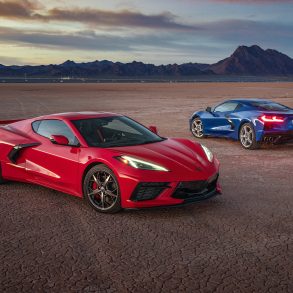


Why are people making a big deal in 2020? Everyone has become so paranoid and delusional. Seriously. Is being around a close friend or relative, or just going to work that dangerous? Please. Get a life, people!